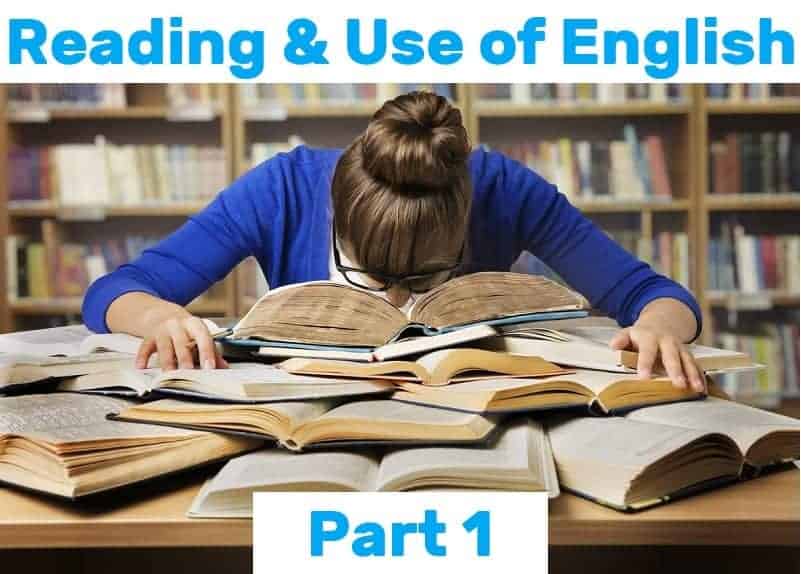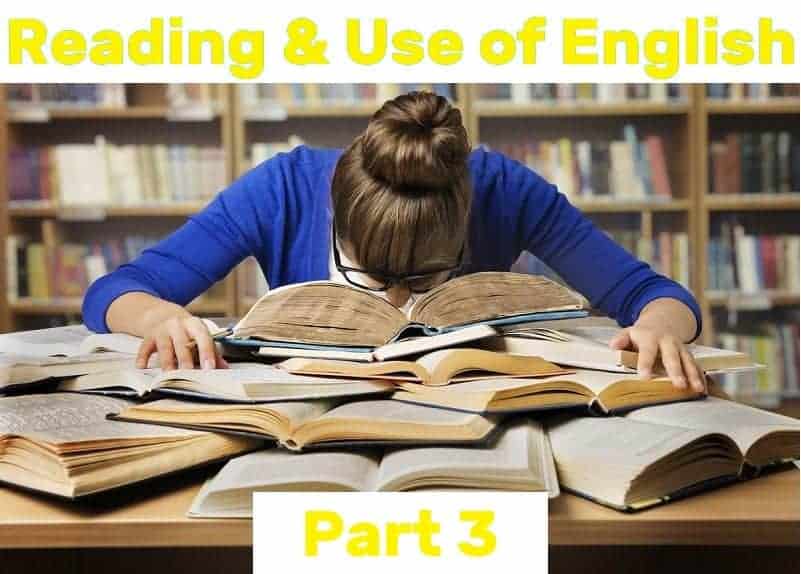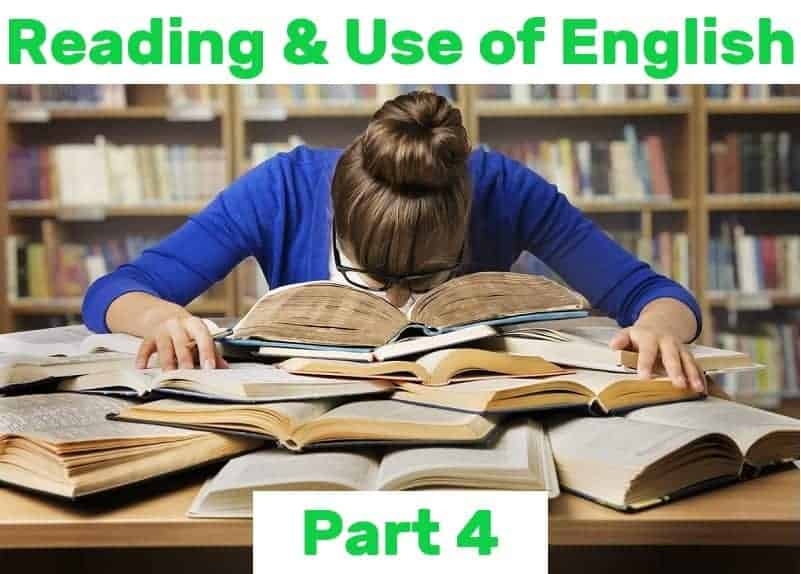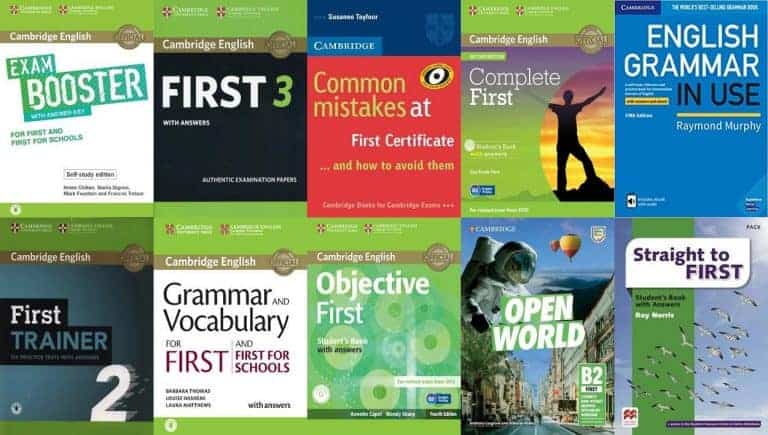Introduction
The FCE Speaking paper is one of the more interesting exams compared to others like IELTS. In the FCE exam you get very varied tasks to do, which means that you have to be prepared for many different topics and to speak under different requirements in each of those tasks.
In Speaking Part 3 you discuss a question with your partner for two minutes and then make a decision together in one minute.
The one part where you really have to interact with your partner and show that you can work well as a team is Speaking Part 3. If you show that you can use the right language and have a balanced conversation with another person (or two if you are in a group of three) under time pressure, you will score high marks quite easily. In this article I’m going to show you exactly how to get there.
When it comes to preparing for Speaking Part 3 there are certain questions that students often ask. The three most common ones I hear are:
- How can I interact well with my partner?
- What is good language to use in this part?
- What are the differences between the two turns in this part?
In this article you will find out the answers to all of these questions. I am going to show you good strategies to manage your time and work together with your partner. We will check some common problems and how to avoid them, and we are going to have a look at two real examples to see what you can do to achieve success in the exam.
How does Speaking Part 3 work?
As with all the other parts of the exam we need to look at the requirements of the task to decide how we want to deal with it. A typical example of Speaking Part 3 could look somewhat like this:
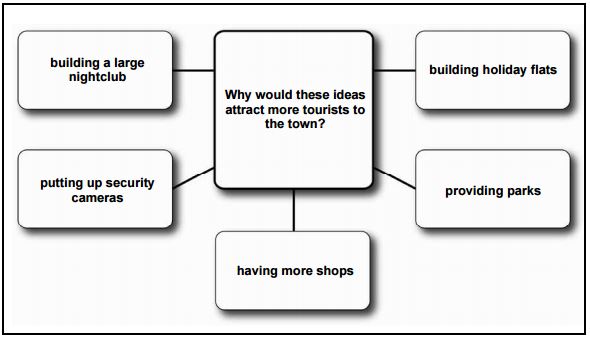
You can see a structure that looks a little bit like a spiderweb. There is a question in the centre and five prompts around it. Speaking Part 3 always follows the same idea: Firstly, you discuss the question with your partner talking about the five prompts for about two minutes and secondly, you have to make a decision based on the same five points in one minute.
The best strategy for Speaking Part 3
As mentioned above, Speaking Part 3 has two sections and for each one you should follow a different plan. Luckily, this plan can be used every time you practise as well as in the exam itself, so let’s see what Teacher Phill’s got for you.
Section 1
In the discussion part you should mostly focus on well structured answers, good language and interaction with your partner. It follows a cycle that you go through together until the examiner stops you after about two minutes. This cycle looks something like this:
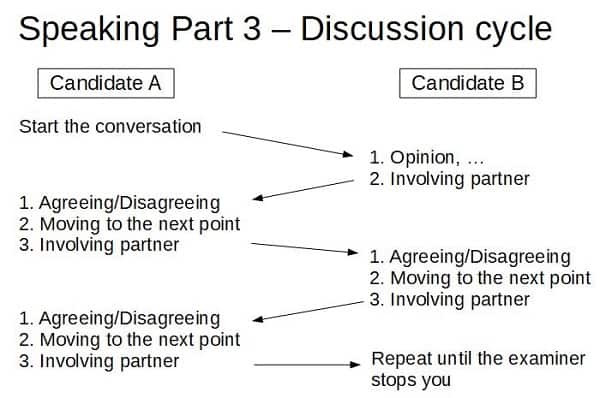
You can see that it is a back and forth between you and your partner and it always follows the same structure. You agree or disagree, you give your opinion (always give reasons and examples to support your argument) and you invite the other candidate back into the conversation. You do this until the two minutes are up and the examiner asks you to stop.
Later in this article we are going to look at two real video examples to see how this works in practice so keep reading.
Section 2
The second section of Speaking Part 3 is different from the first one in a couple of ways. Number one, you have only one minute and number two, you have to decide something with your partner instead of discussing the question in the spiderweb. It is very important for you to have the right strategy in order to balance your talking time and to work towards a decision.
Just as before, however, there is a model that you can and should use:
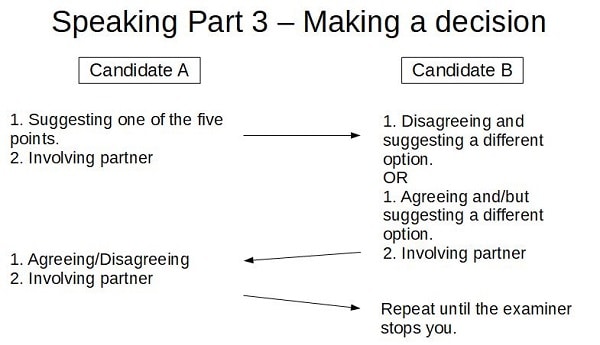
It always works the same. Candidate A starts by suggesting one of the five prompts giving reasons for his/her answer. The next step is the most important part. Candidate B has to suggest another option because if you simply agree, there won’t be anything left to talk about. The problem is that you need to speak until the examiner stops you.
For this reason, Candidate B always offers another option so that you can choose between two of the points. This way, you can talk to each other for the full minute using some nice language (keep reading below for good examples) and interacting with each other.
If this sounds very complicated, don’t worry because as I said earlier, we are going to check out two real-life examples later in this article so you can see exactly how it works.
- Cambridge B2 First (FCE): How to Write an Email/Letter
- Cambridge B2 First (FCE): How to Write an Essay
- Cambridge B2 First (FCE): How to Write a Review
- Cambridge B2 First (FCE): How to Write a Report
- Cambridge B2 First (FCE): How to Write an Article
- Cambridge B2 First (FCE): How to Write an Email/Letter
- Cambridge B2 First (FCE): How to Write an Essay
Don’t make these mistakes
Even though this might sound very straightforward, there are some very typical mistakes that candidates make and I want to show you how to avoid them. If you want to know more about other common mistakes in Part 2 of the FCE Speaking exam, you can read my other article right here in which I tell you exactly what many people do wrong and how you can it better. Here we are only going to focus on Speaking Part 3 so jump over to my other post to get even more great tips.
1. Useful language really helps
Teachers like me always try to get their students to use some specific language. It really helps you to stay on task instead of talking about unrelated things and because examiners look for these expressions you can also score good marks if you put some of them in your test.
In Speaking Part 3, we can put our useful phrases in three different groups: giving your opinion, agreeing/disagreeing and inviting your partner to speak. Let’s have a look at some examples.
| Giving your opinion |
| I think … I think a large nightclub could definitely bring more tourists to a town, especially people who want to visit just for a day. I believe … More security cameras make people feel safe so I believe it can be a good idea to attract more tourists. I feel … I feel that more shops, and especially designer shops, can attract wealthier tourists who are willing to spend more money. In my opinion, … Providing parks, in my opinion, is a very good way to please people living in a town, but I’m not sure how it can help increase the number of tourists. I would say … I would say that if you build new modern holiday flats, it can definitely attract new tourists to your town. From my point of view / In my view, … In my view, more shops can attract more tourists. From my perspective, … From my perspective, the added security because of more cameras can bring more tourists to the town. It seems to me that … It seems to me that a large nightclub can improve the offers a town can make to potential tourists. |
| Agreeing |
| A: I think nightclubs are a great way to attract tourists B: So do I. OR Me too. OR Definitely. OR I couldn’t agree more. OR I agree. OR I see your point. |
| Disagreeing |
| A: In my opinion, modern accommodation is definitely a good reason for tourists to choose one destination over another. B: I disagree. OR I’m not sure if I can agree with you. OR Yeah, but … OR I’m sorry, but I don’t agree. OR I’m afraid I disagree. OR I see what you’re trying to say, but … OR I understand where you’re coming from, but … |
Be careful because we never say “I am agree/disagree.” In English, agree and disagree are verbs and they don’t need another verb. So, always use “I agree/disagree.”
| Inviting your partner to speak |
| Shall we start …? Shall we start talking about nightclubs? What about …? OK, and what about parks? Why do you think they could attract more visitors? Do you agree? … and that’s why I think parks can attract tourists to the town. Do you agree? What do you think? … and because of this, more shops equals more tourists. What do you think? What about you? I think modern holiday apartments can be a deciding factor when you choose where to go. What about you? |
Remember that examiners want you to use these kinds of expressions in your exam. Practise them and try to put some of them in there when it is your turn. The good marks will follow.
2. Always involve your partner
In Speaking Part 3 it is really important to show good teamwork. The interaction between you and your partner is one of the main marking criteria in the FCE speaking exam. That’s why you should always make sure to take turns, put in some useful language and balance out your talking time.
I always tell my students to treat the interaction in the speaking exam as a game of badminton or ping pong. I remember that, when I was a child, I would play these games a lot with my friends and we always tried to keep the ball in the air for as long as we could trying to break our own record every day. Try to keep the ball in the air by involving your partner. Ask them for their opinion, invite them to share their view and respond to what they say. Be a team like the guys below!

3. Don’t go too fast
Time limits always put some kind of pressure on people and in Speaking Part 3 this is not different. What nobody tells you, however, is that you don’t need to finish before the time is up. Actually, the opposite is true. Examiners want you to interact well and support your answers with reasons and examples instead of racing through the task like there is no tomorrow.
What does that mean for you? It means that you don’t have to talk about all five prompts in the discussion stage of Speaking Part 3. It is completely fine to speak about just three or four of the points, but to do it properly.
I’m sure you’ve heard the story of the tortoise and the hare. They challenge each other for a race and the hare thinks that he’s going to win because he is a lot faster, but eventually, the tortoise overtakes him because he is completely exhausted. Treat Speaking Part 3 the same way as the tortoise: Slow and steady wins the race!

4. Discussing…deciding…what’s the difference?
The two sections of Speaking Part 3 come with clear differences regarding what you have to do. While in the first section you have to discuss the question in the spider web, you have to make a decision in the second section.
Unfortunately, candidates often mix these two up and already compare the different points in the discussion stage. Don’t make the same mistake. Answer the question separately for each of the five prompts and compare them only during the second stage. It takes a little bit of practice to get used to this, but after some time you become accustomed to it.
5. Don’t forget to listen to your partner
I have said it several times throughout this article, but I will say it again: the way you interact with your partner is one of the most important factors in Speaking Part 3. The problem is that interaction always goes in two directions. One person speaks and the other one listens. For many of us, including myself, the listening part is more difficult and we often don’t really react to out partner’s opinion or suggestions.
However, in the exam this is exactly what you need to do. Listen actively to your partner and refer to what they say in your reply. Let me give you an example: Imagine your partner just told you that she thinks having more shops could bring more tourists to a town because there has been a trend to go shopping at your holiday destination. Now, you could give a reply like this:
I see where you’re coming from, but I have never felt like going shopping when I’m on holiday and, as far as I know, neither have my friends nor family.
In the reply there are a few good things. Firstly, we can find some useful language (“I see where you’re coming from, …”) and secondly we refer directly to the things our partner said. Examiners would love this so you should do the same.
Learning from examples is always best
To finish this article off we are going to have a look at two examples recorded by Cambridge English. In the two video clips you will see real English students taking Part 3 of the FCE Speaking exam. I’m going to give some commentary on what I think the students do well or in which areas they can improve. However, because I’m not an official speaking examiner, I can’t give them marks as this could give you the wrong idea. Again, these are just examples and I hope that you can take something away to improve your own speaking.
Example 1
Victoria and Edward both use a nice range of useful expressions throughout the first section, for example, to involve their partner and invite each other to give their opinion (What do you think? What about …? What’s your opinion?), to introduce their opinion (I think …; I think it’s a good idea, but …) and to agree/disagree with each other (“Sorry, but I cannot agree with you.”) They have a nicely balanced conversation and work together well and they don’t rush but take their time to talk about some but not all of the points given in the task and to support their arguments.
However, they also have problems with really answering the question, which is why the different ideas can attract more tourists to the town. Victoria and Edward discuss more whether or not these things attract visitors. Always make sure that you read the question carefully before you start to speak and stay on topic without saying unrelated things.
Overall, I think the discussion part wasn’t too bad. There are some smaller language problems too, but in my opinion, they did quite well.
In the second section Victoria and Edward have to decide which idea would be the best one for the town. Victoria takes the initiative and suggests one of the options and Edward suggests another one just as I’ve already shown you in the strategy section of this article. Once again, they balance the talking time well and work together as a team.
They also have a little discussion, but Victoria doesn’t really defend her position and agrees with Edward very quickly, which leaves them in an awkward situation and not much more to say at around 45 seconds into the task. They do recover, though, and get to the full minute, but that could definitely have been better.
To sum up, both candidates do a good job involving their partner and using some nice expressions. However, there are certain things that could be improved, for example, staying on task and expanding on their ideas. All in all, they can be happy with their Speaking Part 3.
Example 2
Florine and Maria use some nice expressions to involve each other (“What do you think about that? Why do you think that?) and to show agreement (“I agree with you.”) Victoria and Edward from the first example above, however, do a better job in this area and Florine and Maria could have used more of the expressions I showed you earlier in this article.
The two candidates also have some problems with answering the task correctly, similar to the other pair. They don’t look at the ideas one by one, but instead compare them at times, which is not what you are supposed to do in the first section of Speaking Part 3.
In the second section Florine immediately takes the initiative and invites Maria to share her opinion. Maria explains why she thinks that holiday apartments are a good idea and Florine offers another option. They discuss their opinions until the examiner stops them. There is a good flow to their conversation and they work together a little bit better than in the first part.
So, while Victoria and Edward in Example 1 are better in the first section, for me, Florine and Maria compensate for that with a slightly stronger second part. Both pairs show solid teamwork, but they aren’t careful enough with the questions the examiner asks them.
With all of this in mind…
… I hope that you feel a little bit more confident about Speaking Part 3. Take the ideas presented in this article and practise with them. Find out what feels good to you and which areas you need to improve.
Remember to stick to the questions, to involve your partner as much as possible and to use a wide range of expressions from the tables above.
Please feel free to leave a comment so I can improve this article in the future and all the best for your preparation.
Lots of love,
Teacher Phill 🙂


